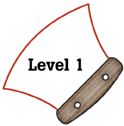|
National Science Education Standards
Organisms have basic needs. For example, animals need air, water, nutrients,
and light. Organisms can survive only in environments in which their needs
can be met. The world has many different environments, and distinct environments
support the life of different types of organisms. (Page 129)
All animals depend on plants. Some animals eat plants for food. Other
animals eat animals that eat plants. (Page 129)
|
|
Benchmarks
Plants and animals both need to take in water, and animals need to take
in food. In addition, plants need light. (Page 119)
Many materials can be recycled and used again, sometimes in different
forms. (Page 119)
|


